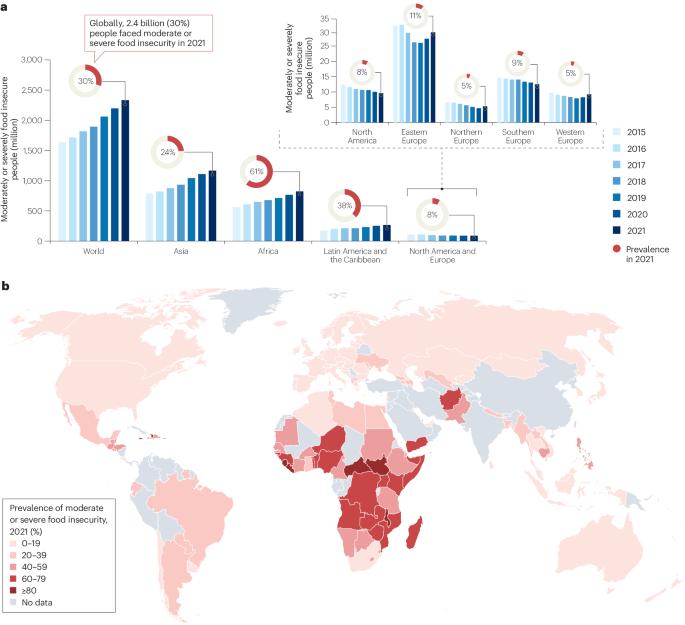粮食不公平和不安全与 MASLD:负担、挑战和干预措施
IF 45.9
1区 医学
Q1 GASTROENTEROLOGY & HEPATOLOGY
引用次数: 0
摘要
肝病的发病率、严重程度、结果和肝病风险因素(如不健康饮食)在很大程度上受到社会经济地位和粮食不安全的影响。代谢功能障碍相关性脂肪性肝病(MASLD)是全球发病率最高的肝病,很可能与其他与粮食不安全相关的肝病同时发生。虽然减轻体重和采用健康饮食可以扭转 MASLD 的病程,但建议与实践之间的差距超越了个人责任和偏好。食物选择的更广泛的社会文化决定因素(社会营养)包括食物不安全、社区和社会规范以及当地环境,包括针对贫困人口、少数民族和儿童的商业压力。粮食不安全是健康饮食的一个障碍,因为低质量的饮食往往比健康饮食更便宜。因此,食物不安全是导致肝病患者出现 MASLD、晚期肝纤维化和全因死亡率升高的 "上游 "风险因素。在四个主要层面(环境、政策、社区和医疗保健)对食物不安全进行干预,可以减轻肝病负担,从而减少社会和健康不公平现象。在本综述中,我们报告了该领域目前的研究情况、实施行之有效的干预措施的必要性以及肝病专家可以发挥的作用。本文章由计算机程序翻译,如有差异,请以英文原文为准。


Food inequity and insecurity and MASLD: burden, challenges, and interventions
Liver disease prevalence, severity, outcomes and hepatic risk factors (for example, unhealthy diet) are heavily affected by socioeconomic status and food insecurity. Metabolic dysfunction-associated steatotic liver disease (MASLD) is the most prevalent liver disease globally and is likely to co-occur with other liver diseases associated with food insecurity. Though weight reduction and adopting a healthy diet can reverse the course of MASLD, gaps between recommendations and practice transcend individual responsibility and preference. Broader sociocultural determinants of food choices (social nutrition) include food insecurity, community and social norms and the local environment, including commercial pressures that target people experiencing poverty, ethnic minorities and children. Food insecurity is a barrier to a healthy diet, as a low-quality diet is often less expensive than a healthy one. Consequently, food insecurity is an ‘upstream’ risk factor for MASLD, advanced fibrosis and greater all-cause mortality among patients with liver disease. Intervening on food insecurity at four major levels (environment, policy, community and health care) can reduce the burden of liver disease, thereby reducing social and health inequities. In this Review, we report on the current research in the field, the need for implementing proven interventions, and the role liver specialists can have. Metabolic dysfunction-associated steatotic liver disease (MASLD) prevalence is increasing worldwide, and a crucial risk factor is food insecurity. This Review provides an extensive overview of food insecurity in the context of MASLD and discusses potential policies and procedures as interventions.
求助全文
通过发布文献求助,成功后即可免费获取论文全文。
去求助
来源期刊
CiteScore
52.30
自引率
0.60%
发文量
147
审稿时长
6-12 weeks
期刊介绍:
Nature Reviews Gastroenterology & Hepatology aims to serve as the leading resource for Reviews and commentaries within the scientific and medical communities it caters to. The journal strives to maintain authority, accessibility, and clarity in its published articles, which are complemented by easily understandable figures, tables, and other display items. Dedicated to providing exceptional service to authors, referees, and readers, the editorial team works diligently to maximize the usefulness and impact of each publication.
The journal encompasses a wide range of content types, including Research Highlights, News & Views, Comments, Reviews, Perspectives, and Consensus Statements, all pertinent to gastroenterologists and hepatologists. With its broad scope, Nature Reviews Gastroenterology & Hepatology ensures that its articles reach a diverse audience, aiming for the widest possible dissemination of valuable information.
Nature Reviews Gastroenterology & Hepatology is part of the Nature Reviews portfolio of journals.

 求助内容:
求助内容: 应助结果提醒方式:
应助结果提醒方式:


